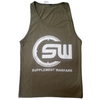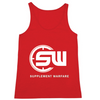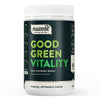
At Supplement Warfare we are frequently asked similar questions from both new users and experienced users alike. Therefore we contacted
Diana Bordean for an interview. Diana is both a physiotherapist and personal Trainer who possess immaculate knowledge in this area. Check out her answers
What’s the cause of the pain in my muscles after working out? How can I reduce these super sore legs?
Delayed onset muscle soreness (DOMS) typically occurs a day or two after the workout and can last several days. It is a result of microscopic tearing of the muscle fibres that then repair to build bigger, stronger muscles. This generally happens when you add a new exercise, or begin exercising after a period of rest, change your exercise routine, or dramatically increase the intensity or duration of your routine. In particular, eccentric exercises or phases of an exercise are thought to cause the most DOMS.
There is no 100% scientifically proven way of reducing DOMS, however several of the below suggestions can be very successful in different individuals:
- Epsom salt bath
- Massage (see below)
- Deep water walking, especially in salty water
- Ice and/or contrast bath especially within the first 48 hours. Ice helps by decreasing inflammation, whilst contrast bath improves circulation, leading to faster recovery
- Supplements (e.g. BCAAs before and after workout, essential amino acids, curcumin to decrease inflammation, fish oil and vitamins)
- Light exercise for active recovery. A recent study (Kenneth et al, 2014) found that light exercise is as effective as massage in relieving post workout aches and pains. The effect of both is only temporary however.
What top 10 tips can you give bodybuilders on recovery and importance of physio?
Physiotherapy treatment - Your muscles take a beating each time you train, so it is important you actively recover them, and prevent injury. Physiotherapy treatment can include a range of techniques/treatment modalities, including, but not limited to soft tissue release/massage, trigger point therapy, myofascial release, dry needling, joint mobilisations, exercise prescription and hydrotherapy. Benefits of physiotherapy treatment include:
- Soft tissue release increases the blood flow to the muscles by increasing muscle tissue permeability and opening micro-circulation. This allows fluids and nutrients to pass through more effectively, and removes waste products that accumulate whilst training, giving you a quicker recovery. You are sure to feel the difference after a good treatment.
- Soft tissue release breaks down the scar tissues and adhesions in the muscles, which have been accumulated over the years, especially if you have been body building for a long time. This releases them to fire and fully contract better, there is more blood and nutrients flowing to those muscles and ultimately more muscle growth! Muscles that are free of scar tissue/adhesions, means improved range of motion for the joints, decreasing risk of injury and allowing for optimal contraction range to grow a fuller muscle belly.

- Physiotherapy treatment reduces the risk of injury; muscle tightness, scar tissues and adhesions limit range of motion. Joints become stiff over time, as the muscles become tighter. Tight muscle bands crossing each other can cause trigger points, which often refer pain elsewhere in the body. Treatment breaks down the adhesions and scar tissues in the muscle, releases trigger points, decreases joint stiffness and stretches the muscle fibres and fascia surrounding the muscle belly. This results in a full range of motion, healthier, more contractile muscles and more blood flow for recovery, and decreases risk of injury.
- Muscular imbalance can alter the joint angle, meaning that the torque of the lever arm becomes less than ideal, and can lead to injury. Muscular imbalance is caused by one or more muscles surrounding a joint being overly dominant, or too tight, whilst others being too weak or long, thus altering its function. Many times the smaller stabilising muscles around the joint are not strong enough or not firing at the right time/phase of the joint angle, leading to a predisposing injury, often accompanied by increased pain over time. A physiotherapist will identify the cause of the muscle imbalance and treat accordingly, by working on those muscles, joints, and giving you corrective exercises and stretches.
- Good form, posture and core activation are essential in weights training. A good physiotherapist will be able to work with you to address any of these areas that need improvement.
Other general tips on recovery include:
- Rest – give your body ample time to rest and recover. Your muscles need to repair and rebuild in order to increase in size and strength. There is nothing worse than doing an excellent workout and not resting to reap the benefits. Over training can lead to decreased performance and increased risk of injury.
- Nutrition – fuel your body with the right nutritious, organic foods in order to repair the tissues, recover, and have enough energy. You may have a basic or complex understanding of nutrition and may already have a diet plan to follow, however if in doubt, speak to a nutritionist or dietician to guide your nutrition. This includes drinking adequate fluids throughout the day, vital in digestion and removal of waste products.
- Stretch – decreases the passive tension in muscles and helps maintain a good joint range of motion. Studies have found that ideal time for stretching is post exercise, rather than pre exercise, with a good warm-up instead pre workout. Static or PNF (proprioceptive neuromuscular facilitation) are both effective.
- Sleep – Never undermine the importance of good quality sleep. It is when your body cells regenerate the most. Growth hormone release, brain cell restoration and energy consumption reduction are just some of the benefits.
- General health and wellbeing – Having a balanced lifestyle is key to success in any area. Stress plays an important role in our lives, and in particular in affecting our sympathetic and parasympathetic nervous systems and our immune system. Your sympathetic system is responsible for the “fight or flight” response, whilst the parasympathetic system is the “rest and digest” phase. It is important we have a good balance of both of these in our daily lives. Too much stress can overload the sympathetic nervous system, which results in overloading the adrenal gland and reducing immune system function. In order for your body to best regenerate itself, it is important that you give your sympathetic nervous system a break by taking time off to relax and recover. This could involve anything and everything that works best for you, from prayer and meditation, to yoga, nature walks, warm baths, or simply lying down and watching a good movie. Never underestimate the power of your mind
Diana Bordean Physiotherapist and Personal Trainer
Marion Physiotherapy 858 Marion Road MARION SA 5043
P: 82967594 F: 8298 9514
http://www.marionphysiotherapy.com.au/
References:
- Decreasing Post-Exertion Muscle Soreness: What's the Best Way?, Huffpost Helathy Living, <http://www.huffingtonpost.com/dr-mercola/sore-muscles_b_3398611.html>.
- Kenneth, J, Sundstrup, E, Sondergaard, SD, Behm, D, Brandt, M, Saervill, CA , 2014, ‘Specific and cross over effects of massage for muscle soreness: randomized controlled trial’, International journal of Sports Physical Therapy, 9(1):82-91.
- Page, P, 2012, ‘Current concepts in muscle stretching for exercise and rehabilitation’, Int J Sports Phys Ther. Feb 2012; 7(1): 109–119.
- August 18, 2014
- Renzo Rigano







Talyene
April 03, 2015
muscle size increased to 150% of its ongiiral size. so more than 2x its ongiiral size. i also retained the strength in my shoulder for 7 years. the size has never shrunk. the reason it doesnt work for many people is because something in their calculation is off. the weight is too light or heavy to not complete for the amount of time needed to do the work. the time alotted is much? too little. rests are too long. longer than 30 seconds. uneccessary rests after sets when not needed continue
Christian
April 05, 2015
volume training work 100% wiotuht a doubt 0%. ive? done it. The problem is with the teachers and authors of all the articles your read. The reason it doesn’t work is because the weight is too heavy or too light AND the reps are TOO LOW. 10 sets is TOO LOW. You will need a weight that is comfortably average . Movements must be 100% EFFICIENT. And you will have to work out for 30-45 minutes on just ONE exercise. You use a the poundages forever until it feels comfortably lighter than before,
Adelia
April 07, 2015
Volume training is anthoer tool to put in the box. I don’t think people should do one kind of workout forever. Try bodybuilding, power lifting, explosive movements, cross training etc. Whatever it takes to keep growing. I love looking buff and? all, but I also value power, speed and endurance. I try to be a complete athlete.